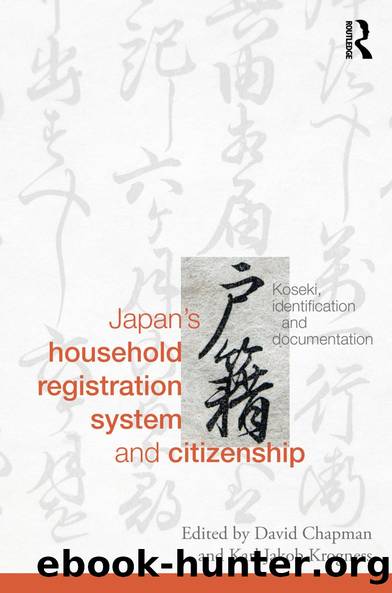Japan's Household Registration System and Citizenship by David Chapman Karl Jakob Krogness

Author:David Chapman, Karl Jakob Krogness [David Chapman, Karl Jakob Krogness]
Language: eng
Format: epub
Tags: Nonfiction, History, Asian, Japan, Social & Cultural Studies, Social Science, Cultural Studies, Ethnic Studies
ISBN: 9781134512980
Publisher: Taylor and Francis
Published: 2014-03-05T05:00:00+00:00
Chinese with Japanese koseki
After the 1972 normalization of diplomatic relations, many zanryū koji who had been six or older at the time of the Japanese defeat were able to find their relatives and identify themselves. The normalization enabled them and the bereaved relatives in Japan to search for each other actively and these older zanryū koji were able to recall their Japanese name, and memories of their parents or their birthplace. On the basis of petitions by zanryū koji and their relatives, their wrongful deletion from the koseki as war dead could be rectified. This enabled them to re-enter their koseki register. However, the Japanese government did not immediately recognize them as Japanese nationals.
As mentioned above, prior to normalization the Japanese government had not recognized the PRC let alone the Chinese nationality of the zanryÅ« koji. Despite the Japanese governmentâs recognition of the Peopleâs Republic of China after normalization, the stance now became that the zanryÅ« koji had divested themselves of their Japanese nationality to become Chinese nationals. Regardless of the individual orphansâ intent, the Japanese government determined administratively that they had lost their Japanese nationality and gained Chinese nationality on the day of the normalization of diplomatic relations, 29 September 1972. All zanryÅ« koji were then considered Chinese citizens, even those who had identified their relatives themselves and managed to confirm and restore their koseki registration. Normalization thus opened up an avenue for the zanryÅ« koji to find their relatives and their own identity but it also closed the door on them being recognized as Japanese nationals.
With this sweeping loss of Japanese nationality, the situation changed from a matter of repatriating Japanese nationals to a question of admitting aliens (i.e. Chinese nationals). The Chinese government was now required to issue zanryÅ« koji a passport so that the Japanese government could issue a visa. It also became necessary for zanryÅ« koji to have a guarantor (mimoto hoshÅnin) who resided in Japan. Furthermore, after the zanryÅ« koji returned to Japan, they needed to register as aliens even if they did have a koseki. If they wanted Japanese nationality they had to apply to the Ministry of Justice for ânaturalizationâ and undergo screening. These measures differed regionally but in the main they continued up until 1986 (Sugawara 1989: 163â64). Such measures were, of course, not applied to regular aliens, so the Japanese government arguably did consider the zanryÅ« koji Japanese. Both the Chinese and Japanese governments positioned them as Chinese in terms of nationality while at the same time considering them to be âpotentiallyâ Japanese or Japanese in transition.
Both governments recognized that the zanryÅ« koji represented a distinctive group of âpotential Japaneseâ people whose lives were altered by the war and colonial policy. While the Chinese government issued passports to support and further the return to Japan of the zanryÅ« koji, the Japanese government severely limited and stymied their return by only issuing visas to those who could secure a guarantor among their Japanese relatives. While they were recognized as potential Japanese, their return to Japan was obstructed.
Download
This site does not store any files on its server. We only index and link to content provided by other sites. Please contact the content providers to delete copyright contents if any and email us, we'll remove relevant links or contents immediately.
| Africa | Americas |
| Arctic & Antarctica | Asia |
| Australia & Oceania | Europe |
| Middle East | Russia |
| United States | World |
| Ancient Civilizations | Military |
| Historical Study & Educational Resources |
Machine Learning at Scale with H2O by Gregory Keys | David Whiting(4169)
Never by Ken Follett(3787)
Fairy Tale by Stephen King(3216)
The Man Who Died Twice by Richard Osman(2995)
Oathbringer (The Stormlight Archive, Book 3) by Brandon Sanderson(2870)
Will by Will Smith(2789)
Rationality by Steven Pinker(2290)
The Dark Hours by Michael Connelly(2243)
Can't Hurt Me: Master Your Mind and Defy the Odds - Clean Edition by David Goggins(2225)
The Dawn of Everything: A New History of Humanity by David Graeber & David Wengrow(2122)
Friends, Lovers, and the Big Terrible Thing by Matthew Perry(2116)
Principles for Dealing With the Changing World Order: Why Nations Succeed and Fail by Ray Dalio(1969)
HBR's 10 Must Reads 2022 by Harvard Business Review(1776)
A Short History of War by Jeremy Black(1758)
Go Tell the Bees That I Am Gone by Diana Gabaldon(1684)
515945210 by Unknown(1597)
A Game of Thrones (The Illustrated Edition) by George R. R. Martin(1586)
Kingdom of Ash by Maas Sarah J(1521)
443319537 by Unknown(1466)
